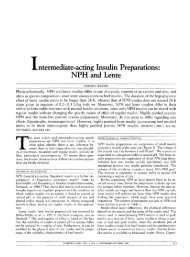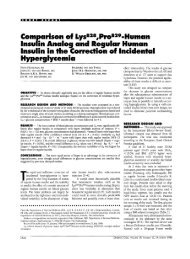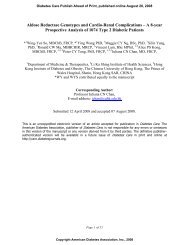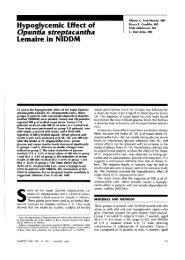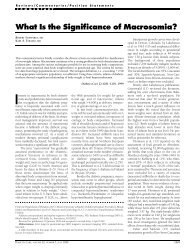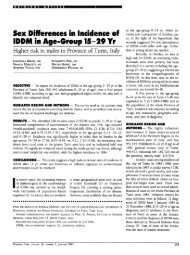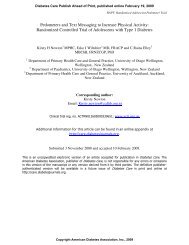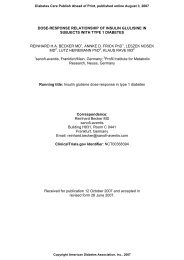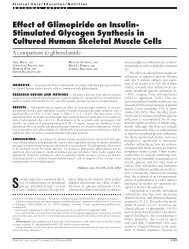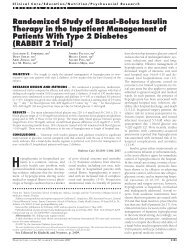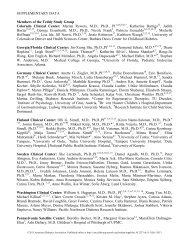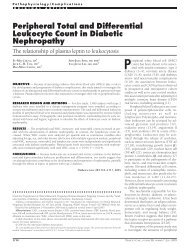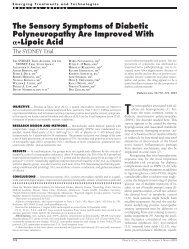An Alternative Approach to the Diagnosis of ... - Diabetes Care
An Alternative Approach to the Diagnosis of ... - Diabetes Care
An Alternative Approach to the Diagnosis of ... - Diabetes Care
You also want an ePaper? Increase the reach of your titles
YUMPU automatically turns print PDFs into web optimized ePapers that Google loves.
R E V I E W A R T I C L E<br />
<strong>An</strong> <strong>Alternative</strong> <strong>Approach</strong> <strong>to</strong><br />
<strong>the</strong> <strong>Diagnosis</strong> <strong>of</strong> <strong>Diabetes</strong><br />
With a Review <strong>of</strong> <strong>the</strong><br />
Literature<br />
MAYER B. DAVIDSON, MD<br />
ANNE L. PETERS, MD<br />
DAVID L. SCHRIGER, MD, MPH<br />
T<br />
wo thoughtful articles in <strong>the</strong> May<br />
1994 issue <strong>of</strong> <strong>Diabetes</strong> <strong>Care</strong> argued<br />
<strong>the</strong> case for screening for type II di-<br />
Knowler (2) discussed <strong>the</strong> general principles<br />
<strong>of</strong> screening and made <strong>the</strong> following<br />
points that are pertinent for diabetes.<br />
abetes (1, 2). Harris and Modan (1) First, hyperglycemia is a continuum, and<br />
pointed out that 1) large population sur- <strong>the</strong>refore <strong>the</strong> choice <strong>of</strong> cu<strong>to</strong>ff values for<br />
veys repeatedly show that approximately diagnosis is somewhat arbitrary. Second,<br />
one-half <strong>of</strong> people with type II diabetes screening for diabetes is unusual because,<br />
are undiagnosed; 2) type II diabetes (i.e., depending on <strong>the</strong> test(s) chosen, <strong>the</strong><br />
hyperglycemia) is present for ~10 years screening test may also be <strong>the</strong> diagnostic<br />
before <strong>the</strong> diagnosis is made; 3) compli- one. Third, as for all diseases, <strong>the</strong> screencations<br />
are <strong>of</strong>ten present at <strong>the</strong> time <strong>of</strong> ing test should have high test-perfor-<br />
diagnosis; 4) diabetes (<strong>of</strong> which type II mance characteristics, i.e., sensitivity,<br />
accounts for 90% <strong>of</strong> cases) exacts a dread- specificity, and predictive value. Finally,<br />
ful <strong>to</strong>ll on <strong>the</strong> population (e.g., 15% <strong>of</strong> all in a nonresearch setting, relatively strin-<br />
blindness, 35% <strong>of</strong> all end stage renal disgent criteria should be selected <strong>to</strong> maxiease,<br />
50% <strong>of</strong> all nontraumatic lower exmize <strong>the</strong> chance that detected subjects<br />
tremity amputations, >100 billion dol- will benefit from <strong>the</strong>rapy. Interestingly,<br />
lars annual cost); 5) it is well established Harris and Modan (1) concluded that <strong>the</strong><br />
that hyperglycemia is <strong>the</strong> proximate cause oral glucose <strong>to</strong>lerance test (OGTT) should<br />
<strong>of</strong> <strong>the</strong> microvascular (retinopathy and ne- be used as <strong>the</strong> primary screening (and diphropathy)<br />
and neuropathic complicaagnostic) method, whereas Knowler (2)<br />
tions <strong>of</strong> diabetes; and 6) early interven- concluded that a glycated hemoglobin<br />
tion (e.g., diet, exercise, medications) is level measurement should be <strong>the</strong> method<br />
helpful in reducing hyperglycemia. <strong>of</strong> choice.<br />
From <strong>the</strong> Department <strong>of</strong> Medicine (M.B.D., A.L.P.), Cedars-Sinai Research Institute, Cedars-<br />
Sinai Medical Center, and <strong>the</strong> UCLA School <strong>of</strong> Medicine (M.B.D., A.L.P., D.L.S.), Los <strong>An</strong>geles,<br />
California.<br />
Address correspondence and reprint requests <strong>to</strong> Mayer B. Davidson, MD, 2103 Overland<br />
Ave., Los <strong>An</strong>geles, CA 90025.<br />
Received for publication 15 August 1994 and accepted in revised form 2 March 1995.<br />
FPG, fasting plasma glucose; IGT, impaired glucose <strong>to</strong>lerance; NDDG, National <strong>Diabetes</strong> Data<br />
Group; NGT, normal glucose <strong>to</strong>lerance; OGTT, oral glucose <strong>to</strong>lerance test; ULN, upper limit <strong>of</strong><br />
normal.<br />
BACKGROUND FOR<br />
DIAGNOSTIC CRITERIA —<br />
Before 1979, <strong>the</strong>re were many different<br />
criteria for interpreting OGTT results (3)<br />
and no consensus existed regarding <strong>the</strong><br />
best cu<strong>to</strong>ff points for diagnosing diabetes.<br />
Studies performed in <strong>the</strong> 1970s and<br />
1980s (4-7) evaluated <strong>the</strong> association between<br />
2-h post-glucose load values<br />
(two studies [6,7] also assessed fasting<br />
plasma glucose [FPG] concentrations,<br />
and in one, glycated hemoglobin levels<br />
were also compared [7]) and <strong>the</strong> subsequent<br />
development <strong>of</strong> <strong>the</strong> microvascular<br />
complications <strong>of</strong> diabetes. These<br />
complications, especially diabetic retinopathy,<br />
are considered <strong>to</strong> be specific<br />
for diabetes. Two <strong>of</strong> <strong>the</strong>se studies (4,5)<br />
evaluated patients who had abnormal<br />
2-h capillary blood glucose values after<br />
administration <strong>of</strong> 50 g <strong>of</strong> oral glucose<br />
(fasting values were not considered).<br />
The patients were classified as ei<strong>the</strong>r diabetic<br />
(2-h blood glucose ^200 mg/dl<br />
[11.1 mmol/1]) or "borderline" diabetic<br />
(2-h blood glucose 120-199 mg/dl<br />
[6.7-11 mmol/1]) and were followed for<br />
5-8 years with ophthalmoscopic examination<br />
through dilated pupils <strong>to</strong> detect<br />
diabetic retinopathy. Diabetic retinopathy<br />
was defined in <strong>the</strong>se studies as <strong>the</strong><br />
presence <strong>of</strong> vascular lesions, such as microaneurysms<br />
alone (small red dots) or<br />
obvious hemorrhage with or without<br />
Table 1—5- <strong>to</strong> 8-year follow-up in subjects<br />
with IGT or diabetes based on a 2-h<br />
capillary blood glucose measurement after a<br />
50-g glucose load<br />
Subjects with diabetic retinopathy<br />
and an initial 2-h blood glucose<br />
measurement<br />
120-199 mg/dl >200 mg/dl<br />
Reference (6.7-11.1 mmol/1) (11.1 mmol/1)<br />
5/245 *<br />
0/112<br />
20/108T<br />
6/38<br />
Three patients who had diabetic retinopathy at<br />
baseline were excluded. TEight patients who had<br />
diabetic retinopathy at baseline were excluded.<br />
DIABETES CARE, VOLUME 18, NUMBER 7, JULY 1995 1065
<strong>Alternative</strong> approach <strong>to</strong> diagnosing diabetes<br />
Table 2—Results <strong>of</strong> a 3-year follow-up in Pima Indians<br />
Initial FPG<br />
140 mg/dl (7.8 mmol/1)<br />
2-h plasma glucose<br />
200 mg/dl (11.1 mmol/1).<br />
n<br />
181<br />
39<br />
117<br />
43<br />
60<br />
Retinopathy<br />
2*<br />
15<br />
0<br />
0<br />
7t<br />
Proteinuria<br />
Data are n at risk at baseline. tThese two patients had a 2-h plasma glucose level ^200 mg/dl (11.1 mmol/1),<br />
and one had an FPG between 130 and 139 mg/dl (7.2-7.7 mmol/1). TFive <strong>of</strong> <strong>the</strong>se patients had FPG<br />
concentrations S140 mg/dl (7.8 mmol/1). Data from Pettitt et al. (6).<br />
exudates. Exudates alone did not constitute<br />
diabetic retinopathy. The results<br />
<strong>of</strong> <strong>the</strong>se studies are summarized in Table<br />
1.<br />
Several <strong>of</strong> <strong>the</strong>se studies were carried<br />
out in Pima Indians (6,7). There is a<br />
high prevalence <strong>of</strong> diabetes in this population,<br />
and fasting and 2-h plasma glucose<br />
concentrations and glycated hemoglobin<br />
levels are found in a bimodal distribution,<br />
which allows for <strong>the</strong> clear identification <strong>of</strong><br />
patients with diabetes. Both cross-sectional<br />
and longitudinal data on diabetes<br />
and its complications in this population<br />
have been collected since 1965. At least<br />
two <strong>of</strong> <strong>the</strong> studies published provide longitudinal<br />
data on <strong>the</strong> development <strong>of</strong> retinopathy<br />
and nephropathy in <strong>the</strong>se patients<br />
for several years compared with<br />
baseline data on glucose <strong>to</strong>lerance (6,7).<br />
Initially, glycated hemoglobin levels were<br />
not available. A 3-year follow-up was provided<br />
for patients who had a 75-g OGTT<br />
with both FPG and 2-h plasma glucose<br />
measured (Table 2), and 6-year follow up<br />
was available for patients who had a measurement<br />
<strong>of</strong> 2-h plasma glucose value<br />
alone (Table 3). The presence or absence<br />
<strong>of</strong> diabetic retinopathy (identified by microaneurysms,<br />
hemorrhages, and neovascularization,<br />
but not hard exudates because<br />
<strong>the</strong>y were considered less specific<br />
for diabetes) was determined based on<br />
ophthalmoscopic examination through<br />
dilated pupils, and <strong>the</strong> presence <strong>of</strong> diabetic<br />
nephropathy was defined as "heavy<br />
proteinuria" (urine protein-<strong>to</strong>-creatinine<br />
0<br />
2<br />
0<br />
0<br />
2<br />
ratio >1.0). These studies suggested that<br />
FPG values > 140 mg/dl (7.8 mmol/1) and<br />
2-h plasma glucose values ^200 mg/dl<br />
(11.1 mmol/1) defined a subset <strong>of</strong> Pima<br />
Indians who were more likely <strong>to</strong> develop<br />
diabetic retinopathy or nephropathy.<br />
In a later study in Pima Indians,<br />
941 patients without retinopathy or nephropathy<br />
at baseline were followed for<br />
4.5 (1.4-8.3) years (7). The development<br />
<strong>of</strong> retinopathy or nephropathy (assessed<br />
using <strong>the</strong> same criteria described above)<br />
during follow-up was compared with<br />
baseline fasting and 2-h glucose concentrations<br />
and glycated hemoglobin levels.<br />
The frequency distributions <strong>of</strong> <strong>the</strong>se three<br />
parameters <strong>of</strong> glycemia were analyzed by<br />
a maximum-likelihood estimation using a<br />
model <strong>of</strong> two overlapping distributions<br />
(7). <strong>An</strong>timodal cutpoints that provided<br />
<strong>the</strong> minimum overlap between <strong>the</strong> two<br />
components <strong>of</strong> <strong>the</strong> distribution were an<br />
FPG concentration <strong>of</strong> 167 mg/dl (9.3<br />
mmol/1), a 2-h plasma glucose concentration<br />
<strong>of</strong> 227 mg/dl (12.6 mmol/1), an<br />
HbAlc level <strong>of</strong> 7.8%, and an HbA: level <strong>of</strong><br />
Table 3—Results <strong>of</strong> a 6-year follow-up in Pima Indians<br />
Initial 2-h blood glucose level<br />
200 mg/dl (11.1 mmol/1)<br />
n<br />
335<br />
111<br />
113<br />
9.4% (7). The ~5 year incidence <strong>of</strong> microvascular<br />
complications in Pima Indians<br />
without <strong>the</strong>se complications at baseline<br />
above and below <strong>the</strong> cutpoints is<br />
shown in Table 4.<br />
This recent study using Pima Indians<br />
is <strong>the</strong> most complete in terms <strong>of</strong><br />
evaluating all <strong>of</strong> <strong>the</strong> glycemic tests for diagnosing<br />
diabetes and <strong>the</strong> development<br />
<strong>of</strong> complications. It was not available at<br />
<strong>the</strong> time <strong>the</strong> National <strong>Diabetes</strong> Data<br />
Group (NDDG) criteria for diagnosing diabetes<br />
were developed (8) (see below),<br />
and it uses somewhat higher glycemic<br />
cutpoints for diagnosing diabetes than<br />
had been used earlier. The conclusions<br />
from all <strong>of</strong> <strong>the</strong>se studies are based on <strong>the</strong><br />
premise that defining glycemic indica<strong>to</strong>rs<br />
that predict <strong>the</strong> development <strong>of</strong> microvascular<br />
complications (particularly retinopathy)<br />
should be used <strong>to</strong> make <strong>the</strong> diagnosis<br />
<strong>of</strong> diabetes.<br />
In <strong>the</strong> studies from <strong>the</strong> 1970s, <strong>the</strong><br />
data defining glycemic cutpoints for diagnosing<br />
diabetes are somewhat sketchy. In<br />
two <strong>of</strong> <strong>the</strong> studies (4,5), FPG concentrations<br />
were not available for <strong>the</strong> individuals<br />
with 2-h plasma glucose concentrations<br />
^200 mg/dl (11.1 mmol/1) who<br />
subsequently developed microvascular<br />
complications, making an analysis <strong>of</strong> FPG<br />
versus 2-h plasma glucose concentrations<br />
impossible. In <strong>the</strong> third study (6), FPG<br />
concentrations were available for subjects<br />
followed for 3 years (but not in those followed<br />
for 6 years). Of <strong>the</strong> seven subjects<br />
who developed retinopathy, all had a 2-h<br />
value ^200 mg/dl (11.1 mmol/1) at baseline.<br />
Five <strong>of</strong> <strong>the</strong>se subjects also had an<br />
FPG concentration ^140 mg/dl (7.8<br />
mmol/1), one had an abnormal FPG con-<br />
Retinopathy<br />
3<br />
3<br />
23<br />
Proteinuria<br />
Data are n at risk at baseline. *Three <strong>of</strong> <strong>the</strong>se subjects had possible causes for developing proteinuria o<strong>the</strong>r<br />
than diabetes. Data from Pettitt et al. (6).<br />
1066 DIABETES CARE, VOLUME 18, NUMBER 7, JULY 1995<br />
4*<br />
0<br />
5
Table A—5-year incidence <strong>of</strong> retinopathy and nephropathy in Pima Indians<br />
Retinopathy<br />
Nephropathy<br />
2-h plasma glucose<br />
[mg/dl (mmol/1)]<br />
227(12.6)<br />
769 (0%) 158 (17.5%)<br />
768 (1.2%) 173 (3.6%)<br />
Data are n at risk at baseline (5-year incidence).<br />
centration between 130-139 mg/dl (7.2-<br />
7.7 mmol/1), and in <strong>the</strong> remaining subject<br />
<strong>the</strong> FPG level was 200(ll.l)<br />
=£200(11.1)<br />
NDDG<br />
Venous whole<br />
blood glucose<br />
< 100 (5.6)<br />
200(ll.l)<br />
—<br />
=£200(11.1)<br />
• Unequivocal elevation <strong>of</strong> plasma glucose<br />
(>200 mg/dl [11.1 mmol/1]) and<br />
classic symp<strong>to</strong>ms <strong>of</strong> diabetes, including<br />
polydipsia, polyuria, polyphagia, and<br />
weight loss.<br />
• FPG >140 mg/dl (7.8 mmol/1) on two<br />
occasions.<br />
WHO<br />
Venous whole<br />
blood glucose<br />
<strong>Alternative</strong> approach <strong>to</strong> diagnosing diabetes<br />
Table 6—Prevalence <strong>of</strong> nondiagnostic OGTT by NDDG criteria and diagnosis by<br />
WHO criteria<br />
Reference<br />
12<br />
13<br />
14<br />
15<br />
Total<br />
Data are n'<br />
Total<br />
OGTT<br />
3704<br />
543<br />
2040<br />
216<br />
6503<br />
Nondiagnostic<br />
OGTT<br />
536<br />
179<br />
405<br />
54<br />
1174(18)<br />
• FPG < 140 mg/dl (7.8 mmol/l) and two<br />
OGTTs with <strong>the</strong> 2-h plasma glucose<br />
^200 mg/dl (11.1 mmol/l) and one intervening<br />
value ^200 mg/dl (11.1<br />
mmol/l) after a 75-g glucose load.<br />
IGT<br />
• FPG < 140 mg/dl (7.8 mmol/l) and 2-h<br />
plasma glucose ^140 (7.8 mmol/l) and<br />
Table 7—Results <strong>of</strong> OGTTs in individuals with glycated hemoglobin levels >\% above<br />
<strong>the</strong> ULN<br />
Reference<br />
25<br />
26<br />
27<br />
28<br />
29<br />
30<br />
31<br />
32<br />
33<br />
34<br />
35<br />
36<br />
37<br />
38<br />
39<br />
40<br />
Total<br />
Total <strong>Diabetes</strong> 1GT NGT Undetermined<br />
22<br />
22<br />
23<br />
14<br />
25<br />
18<br />
38<br />
57<br />
43<br />
22<br />
49<br />
12<br />
87<br />
14<br />
12<br />
8<br />
466<br />
21<br />
22<br />
23<br />
13<br />
24<br />
17<br />
37<br />
54<br />
41<br />
22<br />
46<br />
12<br />
84<br />
14<br />
6<br />
8<br />
444<br />
1<br />
—<br />
—<br />
—<br />
1<br />
1<br />
1<br />
1<br />
2<br />
—<br />
3<br />
—<br />
3<br />
—<br />
3<br />
—<br />
16<br />
—<br />
—<br />
—<br />
—<br />
—<br />
2<br />
3<br />
5 1<br />
Data are n. For those undetermined, information not available <strong>to</strong> determine if individual was normal or had<br />
IGT. Positive predictive value = true positive X 100/true positives + false positives = 95.3%.<br />
physicians revealed that over two-thirds<br />
never considered ordering an OGTT <strong>to</strong><br />
diagnose diabetes (22). In fact,
<strong>Alternative</strong> approach <strong>to</strong> diagnosing diabetes<br />
stitute a diagnosis but would simply alert<br />
<strong>the</strong>se individuals (and <strong>the</strong>ir physicians) <strong>to</strong><br />
<strong>the</strong> potential benefits <strong>of</strong> altering <strong>the</strong>ir lifestyles<br />
<strong>to</strong> minimize <strong>the</strong>se risks. Regardless<br />
<strong>of</strong> <strong>the</strong> results if an OGTT were performed<br />
in subjects with glycated hemoglobin levels<br />
120% <strong>of</strong> desirable body weight); 3)<br />
Native American, African American, or<br />
Hispanic ethnicity; 4) previously identified<br />
IGT; 5) hypertension or dyslipidemia;<br />
or 6) his<strong>to</strong>ry <strong>of</strong> gestational diabetes<br />
or delivery <strong>of</strong> a baby weighing >9 lb.<br />
Since diabetes is so common in <strong>the</strong> elderly,<br />
consideration should also be given <strong>to</strong><br />
measuring FPG concentrations in those<br />
>65 years <strong>of</strong> age regardless <strong>of</strong> risk fac<strong>to</strong>rs.<br />
References<br />
1. Harris MI, Modan M: Screening for<br />
NIDDM: why is <strong>the</strong>re no national program?<br />
<strong>Diabetes</strong> <strong>Care</strong> 17:440-444, 1994<br />
2. Knowler WC: Screening for NIDDM: opportunities<br />
for detection, treatment, and<br />
prevention. <strong>Diabetes</strong> <strong>Care</strong> 17:445-450,<br />
1994<br />
3. Valleron AJ, Eschwege E, Papoz L, Rosselin<br />
GE: Agreement and discrepancy in <strong>the</strong><br />
evaluation <strong>of</strong> normal and diabetic oral<br />
glucose <strong>to</strong>lerance test. <strong>Diabetes</strong> 24:585-<br />
596,1975<br />
4. Jarrett RJ, Keen H: Hyperglycaemia and<br />
diabetes mellitus. Lancet ii: 1009-1012,<br />
1976<br />
5. Sayegh HA, Jarrett RJ: Oral glucose<strong>to</strong>lerance<br />
tests and <strong>the</strong> diagnosis <strong>of</strong> diabetes:<br />
results <strong>of</strong> a prospective study based<br />
on <strong>the</strong> Whitehall survey. Lancet ii:431-<br />
433,1979<br />
6. Pettitt DJ, Knowler WC, Lisse JR, Bennett<br />
PH: Development <strong>of</strong> retinopathy and proteinuria<br />
in relation <strong>to</strong> plasma-glucose<br />
concentrations in Pima Indians. Lancet ii:<br />
1050-1052, 1980<br />
7. McCance DR, Hanson RL, Charles MA,<br />
Jacobsson LTH, Pettitt DJ, Bennett PH,<br />
Knowler WC: Comparison <strong>of</strong> tests for glycated<br />
haemoglobin and fasting and two<br />
hour plasma glucose concentrations as diagnostic<br />
methods for diabetes. Br Med J<br />
308:1323-1328, 1994<br />
8. National <strong>Diabetes</strong> Data Group: Classification<br />
and diagnosis <strong>of</strong> diabetes mellitus<br />
and o<strong>the</strong>r categories <strong>of</strong> glucose in<strong>to</strong>lerance.<br />
<strong>Diabetes</strong> 28:1039-1057, 1979<br />
9. American <strong>Diabetes</strong> Association Position<br />
Statement: Office guide <strong>to</strong> diagnosis and<br />
classification <strong>of</strong> diabetes mellitus and<br />
o<strong>the</strong>r categories <strong>of</strong> glucose in<strong>to</strong>lerance.<br />
<strong>Diabetes</strong> <strong>Care</strong> 16 (Suppl. 2):4, 1993<br />
10. World Health Organization: <strong>Diabetes</strong> Mellitus:<br />
Report <strong>of</strong> a WHO Study Group. Geneva,<br />
World Health Org., 1985 (Tech.<br />
Rep. Ser.,no. 727)<br />
11. American <strong>Diabetes</strong> Association Committee<br />
on Statistics: Standardization <strong>of</strong> <strong>the</strong><br />
oral glucose <strong>to</strong>lerance test. <strong>Diabetes</strong> 18:<br />
299-310, 1969<br />
12. Harris MI, Hadden WC, Knowler WC,<br />
Bennett PH: International criteria for <strong>the</strong><br />
diagnosis <strong>of</strong> diabetes and impaired glucose<br />
<strong>to</strong>lerance. <strong>Diabetes</strong> <strong>Care</strong> 8:562-567,<br />
1985<br />
13. Massari V, Eschwege E, Valleron AH: Imprecision<br />
<strong>of</strong> new criteria for <strong>the</strong> oral glucose<br />
<strong>to</strong>lerance test. Diabe<strong>to</strong>logia 24:100-<br />
106,1983<br />
14. Modan M, Halkin H, Karasik A, Lusky A:<br />
Effectiveness <strong>of</strong> glycosylated hemoglobin,<br />
fasting plasma glucose, and a single post<br />
load plasma glucose level in population<br />
screening for glucose in<strong>to</strong>lerance. Am J<br />
Epidemiol 119:431-444, 1984<br />
15. Forrest RD, Jackson CA, Yudkin JS: The<br />
abbreviated glucose <strong>to</strong>lerance test in<br />
screening for diabetes: The Isling<strong>to</strong>n <strong>Diabetes</strong><br />
Survey. Diabetic Med 5:557-561,<br />
1988<br />
16. Modan M, Harris MI, Halkin H: Evaluation<br />
<strong>of</strong> WHO and NDDG criteria for impaired<br />
glucose <strong>to</strong>lerance: results from two<br />
national samples. <strong>Diabetes</strong> 38:1630-<br />
1635, 1989<br />
17. Olefsky JM, Reaven GM: Insulin and glucose<br />
responses <strong>to</strong> identical oral glucose<br />
<strong>to</strong>lerance tests performed forty-eight<br />
hours apart. <strong>Diabetes</strong> 23:449-453, 1974<br />
18. Kosaka K, Mizuno Y, Kuzuga T: Reproducibility<br />
<strong>of</strong> <strong>the</strong> oral glucose <strong>to</strong>lerance test<br />
and <strong>the</strong> rice-meal test in mild diabetes.<br />
<strong>Diabetes</strong> 15:901-904, 1966<br />
19. Wilkerson HLC, Butler FK, Francis JO'S:<br />
The effect <strong>of</strong> prior carbohydrate intake on<br />
<strong>the</strong> oral glucose <strong>to</strong>lerance test. <strong>Diabetes</strong><br />
9:386-391, 1960<br />
20. Aparicio NJ, Puchulu FE, Gagliardino JJ,<br />
Ruiz M, Llorens JM, Ruiz J, Lamas A, De<br />
Miguel R: Circadian variation <strong>of</strong> <strong>the</strong> blood<br />
glucose, plasma insulin and human<br />
growth hormone levels in response <strong>to</strong> an<br />
oral glucose load in normal subjects. <strong>Diabetes</strong><br />
23:132-137, 1974<br />
1070 DIABETES CARE, VOLUME 18, NUMBER 7, JULY 1995
21. Rushforth NB, Miller M, Bennett PH:<br />
Fasting and two-hour post-load glucose<br />
levels for <strong>the</strong> diagnosis <strong>of</strong> diabetes. Diabe<strong>to</strong>logia<br />
16:373-379, 1979<br />
22. Orchard TJ: From diagnosis and classification<br />
<strong>to</strong> complications and <strong>the</strong>rapy. <strong>Diabetes</strong><br />
<strong>Care</strong> 17:326-338, 1994<br />
23. Mel<strong>to</strong>n LJ, Palumbo PJ, Chu C-P: Incidence<br />
<strong>of</strong> diabetes mellitus by clinical type.<br />
<strong>Diabetes</strong> <strong>Care</strong> 6:75-86, 1983<br />
24. The <strong>Diabetes</strong> Control and Complications<br />
Trial Research Group: The effect <strong>of</strong> intensive<br />
treatment <strong>of</strong> diabetes on <strong>the</strong> development<br />
and progression <strong>of</strong> long-term complications<br />
in insulin-dependent diabetes<br />
meilitus. N Engl J Med 329:977-986,<br />
1993<br />
25. Boucher BJ, Welch SG, Beer MS: Glycosylated<br />
haemoglobins in <strong>the</strong> diagnosis <strong>of</strong> diabetes<br />
meilitus and impaired glucose <strong>to</strong>lerance<br />
for <strong>the</strong> assessment <strong>of</strong> chronic<br />
hyperglycemia. Diabe<strong>to</strong>logia 21:34-36,<br />
1981<br />
26. Svendsen PA,JorgensenJ, NerupJ: HbAlc<br />
and <strong>the</strong> diagnosis <strong>of</strong> diabetes meilitus.<br />
Ada Med Scand 210:313-316,1981<br />
27. Clipson KL, Kansal PC, Poon M-C,<br />
Boshell BR: Hemoglobin Ax in <strong>the</strong> diagnosis<br />
<strong>of</strong> chemical diabetes meilitus. Horm<br />
MetabRes 13:129-131, 1982<br />
28. Kesson CM, Youn RE, Talwar D,<br />
WhitelawJW, Robb DA: Glycosylated hemoglobin<br />
in <strong>the</strong> diagnosis <strong>of</strong> non-insulindependent<br />
diabetes meilitus. <strong>Diabetes</strong><br />
<strong>Care</strong> 5:395-398, 1982<br />
29. Verillo A, De Teresa A, Golia R, Nunziata<br />
V: The relationship between glycosylated<br />
haemoglobin levels and various degrees<br />
<strong>of</strong> glucose in<strong>to</strong>lerance. Diabe<strong>to</strong>logia 24:<br />
391-393, 1983<br />
30. Hall PM, John, MS, Cook G, Sheldon J,<br />
Ru<strong>the</strong>rford SM, Gould BJ: Glycosylated<br />
hemoglobins and glycosylated plasma<br />
proteins in <strong>the</strong> diagnosis <strong>of</strong> diabetes meilitus<br />
and impaired glucose <strong>to</strong>lerance. <strong>Diabetes</strong><br />
<strong>Care</strong> 7:147-150, 1984<br />
31. CederholmJ, Ronquist G, Wibell L: Comparison<br />
<strong>of</strong> glycosylated hemoglobin with<br />
<strong>the</strong> oral glucose <strong>to</strong>lerance test: a study in<br />
subjects with normoglycemia, glucose in<strong>to</strong>lerance<br />
and non-insulin-dependent diabetes<br />
meilitus. Diabete & Metab 10:224-<br />
229,1984<br />
32. Albutt EC, Nattrass M, Northam BE: Glucose<br />
<strong>to</strong>lerance test and glycosylated haemoglobin<br />
measurement for diagnosis <strong>of</strong><br />
diabetes mellitus:an assessment <strong>of</strong> <strong>the</strong> criteria<br />
<strong>of</strong> <strong>the</strong> WHO expert committee on<br />
diabetes meilitus 1980. <strong>An</strong>n Clin Biochem<br />
22:67-73, 1985<br />
33. Lester E, Frazer AD, Shepherd CA, Woddr<strong>of</strong>fe<br />
FJ: Glycosylated haemoglobin as an<br />
alternative <strong>to</strong> <strong>the</strong> glucose <strong>to</strong>lerance test for<br />
<strong>the</strong> diagnosis <strong>of</strong> diabetes meilitus. <strong>An</strong>n<br />
Clin Biochem 22:74-78, 1985<br />
34. Jeppsson J-O, Jeren<strong>to</strong>rp P, Sundkvist G,<br />
Englund H, Nylund V: Measurement <strong>of</strong><br />
hemoglobin Alc by a new liquid-chroma<strong>to</strong>graphic<br />
assay: methodology, clinical<br />
utility, and relation <strong>to</strong> glucose <strong>to</strong>lerance<br />
evaluated. Clin Chem 32:1867-1872,1986<br />
35. John WG, Richardson RW: Glycosylated<br />
haemoglobin levels in patients referred<br />
for oral glucose <strong>to</strong>lerance tests. Diabetic<br />
Med 3:46-48, 1986<br />
36. Forrest RD, Jackson CA, Yudkin JS: The<br />
glycohaemoglobin assay as a screen or<br />
screening test for diabetes meilitus: The<br />
Isling<strong>to</strong>n <strong>Diabetes</strong> Survey. Diabetic Med<br />
4:254-259, 1987<br />
37. Little RR, England JD, Wiedmeyer H-M,<br />
McKenzie EM, Pettitt DJ, Knowler WC,<br />
Goldstein DE: Relationship <strong>of</strong> glycosylated<br />
hemoglobin <strong>to</strong> oral glucose <strong>to</strong>lerance.<br />
<strong>Diabetes</strong> 37:60-64, 1988<br />
38. Guillauseau PJ, Charles MA, Paolaggi F,<br />
Timsit J, Chanson P, Peynet J, Godard<br />
V, Eschwege E, Rousselet F, Lubetzki J:<br />
Comparison <strong>of</strong> HbAx and fruc<strong>to</strong>samine<br />
in diagnosis <strong>of</strong> glucose-<strong>to</strong>lerance abnormalities.<br />
<strong>Diabetes</strong> <strong>Care</strong> 13:898-900,<br />
1990<br />
39. Motala AA, Omar MAK: The value <strong>of</strong> glycosylated<br />
haemoglobin as a substitute for<br />
<strong>the</strong> oral glucose <strong>to</strong>lerance test in <strong>the</strong> detection<br />
<strong>of</strong> impaired glucose <strong>to</strong>lerance<br />
(IGT). Diab Res Clin Pract 17:199-207,<br />
1992<br />
Davidson, Peters, and Schriger<br />
40. Santiago JV, DavisJE, Fisher F: Hemoglobin<br />
Alc levels in a diabetes detection program.<br />
J Clin Endocrinol Metab 47:578-<br />
580.1978<br />
41. Tsuji I, Nakamo<strong>to</strong> K, Hasegawa T,<br />
Hisashige A, Inawashiro H, Fukao A, Hismichi<br />
S: Receiver operating characteristic<br />
analysis on fasting plasma glucose,<br />
HbAlc, and fruc<strong>to</strong>samine on diabetes<br />
screening. <strong>Diabetes</strong> <strong>Care</strong> 14:1075-1077,<br />
1991<br />
42. Larsen ML: The utility <strong>of</strong> glycated hemoglobin<br />
in identification <strong>of</strong> impaired glucose<br />
<strong>to</strong>lerance. <strong>Diabetes</strong> Res 12:67-70,<br />
1989<br />
43. Bolli G, Compagnucci P, Cartechini MG,<br />
Santeusanio F, Cirot<strong>to</strong> C, Scionti L, Brunetti<br />
P: HbAL in subjects with abnormal<br />
glucose <strong>to</strong>lerance but normal fasting<br />
plasma glucose. <strong>Diabetes</strong> 29:272-277,<br />
1980<br />
44. Flock EV, Bennett PH, Savage PJ, Webner<br />
CJ, Howard BV, Rushforth NB, Miller M:<br />
Bimodality <strong>of</strong> glycosylated hemoglobin<br />
distribution in Pima Indians. <strong>Diabetes</strong> 28:<br />
984-989,1979<br />
45. Dix D, Cohen P, Kingsley S, Senkbeil J,<br />
Sex<strong>to</strong>n K: Glycohemoglobin and glucose<br />
<strong>to</strong>lerance tests compared as indica<strong>to</strong>rs <strong>of</strong><br />
borderline diabetes. Clin Chem 25:877-<br />
879.1979<br />
46. Lev-Ran A, VanderLaan WP: Glycohemoglobins<br />
and glucose <strong>to</strong>lerance. JAMA 241:<br />
912-914, 1979<br />
47. Orchard TJ, Daneman D, Becker DJ,<br />
Kuller LH, LaPorte RE, Drash AL, Wagener<br />
D: Glycosylated hemoglobin: a<br />
screening test for diabetes meilitus? Preventive<br />
Med 11:595-601, 1982<br />
48. Shima K, Abe F, Chikakiyo H, I<strong>to</strong> N: The<br />
relative value <strong>of</strong> glycated albumin, hemoglobin<br />
Alc and fruc<strong>to</strong>samine when<br />
screening for diabetes meilitus. Diab Res<br />
Clin Pract 7:243-250, 1989<br />
49. Charles MA, Fontbonne A, Thibult N,<br />
Warnet J-M, Rosselin GE, Eschwege E:<br />
Risk fac<strong>to</strong>rs for NIDDM in white population.<br />
<strong>Diabetes</strong> 40:796-799, 1991<br />
DIABETES CARE, VOLUME 18, NUMBER 7, JULY 1995 1071



